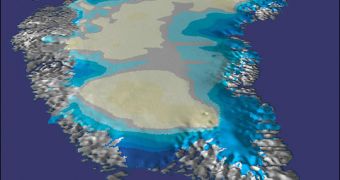According to a new research, published by British and American researchers in the journal Nature Geoscience, the melting of the Greenland ice sheet may be nothing more than a localized phenomenon, and the process through which the ice sheet disintegrates, threatening the lives and possessions of hundreds of millions of people worldwide, could stop on its own over the next decades. The study analyzed data spanning multiple years, yet it only concentrates on a small portion of the Greenland ice sheet.
Durham University professor Andreas Vieli, co-author of the new paper, says that the team only focused its efforts on studying the Helheim Glacier, and that their results are not conclusive for the entire ice sheet in the region. The study also cannot be held as a reference point in analyzing other areas of the globe, such as the Antarctic, and mountaintop glaciers. The paper should not "be taken out of context to suggest that climate change is not a serious threat – it is," Vieli cautions.
"Whatever happens at the terminus provokes a strong and rapid reaction in the rest of the glacier. The result has been a significant loss of mass. You cannot maintain these very high rates of peak mass loss for very long. The glaciers start to retreat and settle into a new and relatively stable state," he says. According to the theory, glaciers, once they reach a critical level, stabilize themselves and start retreating, thus eliminating the risk of them melting at the same time.
Of course, it's always possible for very large bits of the sheet to split apart from their place and drift into the ocean, but the research team believes that this trend will not significantly increase the danger that global flooding poses to millions of people living in low-lying areas of the world. Some of the most susceptible areas, in terms of potential casualties, include the East Coast of the US, Japan, China's east coast, Southern India and Bangladesh, as well as a number of African nations.
According to scientific estimates, sea levels worldwide could increase by as much as 7 meters (roughly 21 feet), if the ice sheets in Greenland were to fall apart. This would account for tremendous devastation throughout the globe, and will cause long-term problems, including housing, food, water and medication for the displaced.
The UN Intergovernmental Panel on Climate Change (IPCC) estimates that sea levels will rise anyway within 100 years, by about 18 to 59 centimeters (7.2 to 23.2 inches), while others in the scientific community say that, most likely, oceans will go up by approximately one meter (3.3 feet) during the same time frame.

 14 DAY TRIAL //
14 DAY TRIAL //